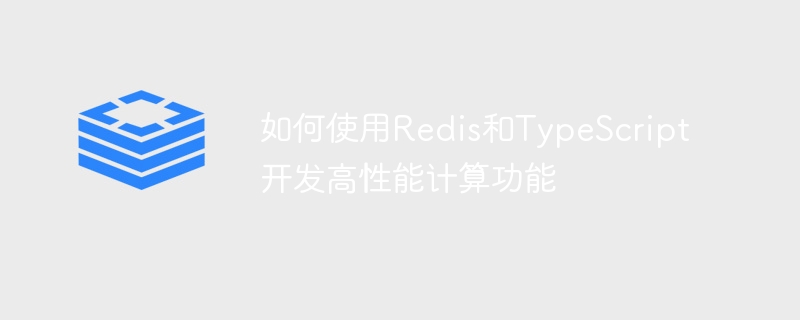How to develop high-performance computing functions using Redis and TypeScript
- PHPzOriginal
- 2023-09-20 11:21:141597browse

How to use Redis and TypeScript to develop high-performance computing functions
Overview:
Redis is an open source in-memory data structure storage system that is high-performance and scalable sexual characteristics. TypeScript is a superset of JavaScript that provides a type system and better development tool support. Combining Redis and TypeScript, we can develop efficient computing functions to process large data sets and make full use of Redis's memory storage and computing capabilities.
This article will introduce how to use Redis and TypeScript to develop high-performance computing functions, including data storage, data processing, and result caching. We will use common data structures and commands of Redis and provide specific code examples.
- Data Storage
First, we need to store the data that needs to be calculated into Redis. Redis provides a variety of data structures, and you can choose the appropriate data structure to store data according to specific needs. Commonly used data structures include String, List, Set, Sorted Set, etc.
For example, we can store the data that needs to be calculated as a list:
import * as Redis from 'ioredis';
const client = new Redis();
// 存储数据到列表中
async function appendDataToList(data: number[]): Promise<void> {
await client.rpush('dataList', ...data.map(String));
}- Data processing
Once the data is stored in Redis, we can perform operations on the data Handle accordingly. Using the commands and data structures provided by Redis, we can implement various calculation functions, such as summation, maximum value, sorting, etc.
For example, we can perform a sum operation on data stored in a list:
import * as Redis from 'ioredis';
const client = new Redis();
// 计算列表中数据的和
async function sumDataInList(): Promise<number> {
const values = await client.lrange('dataList', 0, -1);
return values.reduce((sum: number, value: string) => sum + parseInt(value), 0);
}- Result cache
In order to improve calculation performance, we can Cache it for subsequent repeated calculations. The caching function of Redis can help us quickly obtain previously calculated results.
For example, we can store the summation results in the cache of Redis:
import * as Redis from 'ioredis';
const client = new Redis();
// 存储结果到缓存中
async function cacheResult(key: string, result: number): Promise<void> {
await client.set(key, String(result));
}
// 从缓存中获取结果
async function getCachedResult(key: string): Promise<number | null> {
const result = await client.get(key);
if (result === null) {
return null;
}
return parseInt(result);
}Using the above technology comprehensively, we can store the data in Redis and calculate the data, And cache the calculation results to improve calculation performance and reusability.
The sample code uses the Node.js library ioredis to connect and operate Redis. You can use other appropriate libraries according to your own development environment and needs.
Summary:
In big data processing and high-performance computing scenarios, the combination of Redis and TypeScript can provide good performance and development experience. By rationally selecting data structures and utilizing the caching features of Redis, we can achieve efficient data storage and computing functions. At the same time, TypeScript’s type system and tool support can reduce development errors and improve code maintainability.
The above is a brief introduction on how to use Redis and TypeScript to develop high-performance computing functions. I hope it will be helpful to you. In actual development, please adjust and optimize according to specific needs and environment.
The above is the detailed content of How to develop high-performance computing functions using Redis and TypeScript. For more information, please follow other related articles on the PHP Chinese website!

